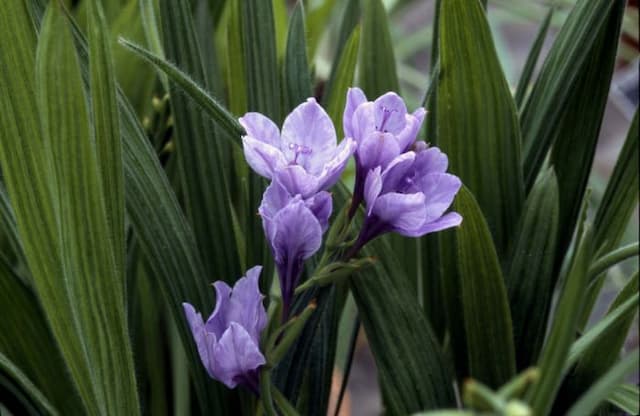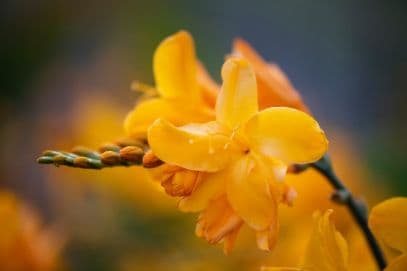Bearded Iris Iris 'Lark Rise' (TB)

ABOUT
Iris 'Lark Rise' is a strikingly beautiful perennial that is part of the tall bearded iris category. This variety is noteworthy for its flamboyant blooms that capture the attention of garden enthusiasts. The flowers of 'Lark Rise' boast a combination of colors. Its petals, known as standards, are typically upright and may present a soothing pastel hue or a more vibrant color depending on the cultivar. The lower petals, called falls, are known to showcase contrasting colors and often have a delightful beard at their base, which is a fuzzy line that can be a contrasting or complementary color to the rest of the flower. The foliage of the Iris 'Lark Rise' consists of long, sword-shaped leaves that emerge from the base of the plant and can provide a vertical architectural element to the garden. The leaves are a bright green together forming a clump that serves as a lush backdrop for the showy blooms perched atop sturdy, erect stalks. Each flowering stalk of 'Lark Rise' can carry several buds that bloom successively, offering a prolonged display of color in the garden. Lastly, this Iris variety blooms in late spring to early summer and adds an elegant touch to any garden with its richly colored flowers and stately foliage. It is a popular choice for borders, flower beds, and as a complement to other perennials in mixed plantings.
About this plant
 Names
NamesFamily
Iridaceae
Synonyms
Bearded Iris, German Iris
Common names
Iris 'Lark Rise' (TB).
 Toxicity
ToxicityTo humans
The Tall Bearded Iris, which includes Iris 'Lark Rise', is generally considered to have a low level of toxicity to humans. However, ingesting parts of the plant, especially the rhizomes (underground stems), can cause digestive upset such as nausea, vomiting, abdominal pain, and diarrhea. Symptoms are typically mild and occur due to the presence of irritant compounds. If large quantities are consumed, more severe symptoms could potentially occur.
To pets
The Tall Bearded Iris, including Iris 'Lark Rise', can be toxic to pets if ingested. The primary toxic components are the rhizomes, which contain compounds that can cause gastrointestinal irritation. Symptoms of poisoning in pets may include drooling, vomiting, diarrhea, lethargy, and abdominal pain. While the toxicity is generally considered low, if a pet consumes a large portion of the plant, more serious health complications could arise, and veterinary attention would be required.
 Characteristics
CharacteristicsLife cycle
Perennials
Foliage type
Deciduous
Color of leaves
Green
Flower color
Mixed
Height
3 feet 0.91 meters
Spread
2 feet 0.61 meters
Plant type
Bulb
Hardiness zones
Varies
Native area
Europe
Benefits
 General Benefits
General Benefits- Ornamental Value: Iris 'Lark Rise' is admired for its beautiful purple flowers which add aesthetic appeal to gardens and landscapes.
- Ease of Cultivation: It is generally easy to grow and doesn’t require much maintenance, making it suitable for many gardeners.
- Drought Tolerance: Once established, these irises are quite drought-tolerant, making them suitable for xeriscaping and low-water gardens.
- Attracts Pollinators: The flowers attract bees and butterflies, which are important pollinators for many plants.
- Seasonal Interest: It blooms in late spring to early summer, providing color and interest in the garden during this time.
- Soil Adaption: Iris 'Lark Rise' is adaptable to a range of soil types, though it prefers well-draining conditions.
- Cold Hardy: It is capable of withstanding cold temperatures, making it suitable for planting in a variety of climates.
- Dividing and Propagation: Can be easily divided to produce more plants which helps in spreading beauty and can be shared with other gardeners.
- Longevity: It can live and bloom for many years with proper care, providing long-term enjoyment.
- Garden Structure: Their tall, upright form can provide structure and height to flower beds and borders.
- Cut Flowers: The blooms are suitable for cutting and can be used to create attractive indoor flower arrangements.
 Medical Properties
Medical PropertiesThis plant is not used for medical purposes.
 Air-purifying Qualities
Air-purifying QualitiesThis plant is not specifically known for air purifying qualities.
 Other Uses
Other Uses- Artistic inspiration: Iris 'Lark Rise' can be used as a muse for artists and photographers due to its striking colors and elegant form, inspiring artwork such as paintings, drawings, and photographic projects.
- Dye source: The petals of an Iris can be used to create natural dyes for fabrics, providing hues that range from soft blues and purples to rich yellows, depending on the part of the plant used.
- Education: The Iris 'Lark Rise' can serve as a botanical subject for educational purposes, demonstrating plant anatomy, pollination biology, and horticultural practices in schools and workshops.
- Garden design: Irises provide structure and height contrast in garden design, making them ideal for creating visually appealing layered planting schemes.
- Crafting: Dried Iris flowers can be incorporated into crafts such as potpourri, wreaths, and pressed flower arrangements for home decor.
- Eco-friendly pest control: When strategically placed in a garden, certain types of Iris can deter deer and rabbits, which find them unpalatable, reducing the need for chemical repellents.
- Water filtration: Some Iris species are effective in water gardens for their phytoremediation properties, helping to filter and clean water in ponds or natural pools.
- Symbolism: Irises can represent wisdom, hope, and valor, and are often used in cultural ceremonies and memorial gardens to convey deep symbolic messages.
- Fragrance extraction: Certain Iris species produce rhizomes that can be processed to extract orris root, used in perfumery and aromatherapy for its distinctive violet-like fragrance.
- Biological indicators: Irises can serve as indicators of environmental health, with their presence or absence providing insights into the conditions of their growing habitat.
Interesting Facts
 Feng Shui
Feng ShuiThe Iris is not used in Feng Shui practice.
 Zodiac Sign Compitability
Zodiac Sign CompitabilityThe Iris is not used in astrology practice.
 Plant Symbolism
Plant Symbolism- Hopes and dreams: The Iris 'Lark Rise' symbolizes hope, similar to the way a lark rises with the dawn, representing new beginnings.
- Faith: The iris is often associated with faith and wisdom due to its majestic appearance and the many myths surrounding it.
- Courage: In ancient times, the iris was a symbol of power and might, with its bold colors and stature suggesting courage and admiration.
- Royalty: The fleur-de-lis, a stylized iris, has been used as a royal symbol, denoting majesty and nobility.
- Purity: White irises, in particular, convey purity and innocence, which can be extrapolated to the Iris 'Lark Rise' given its light coloring.
 Water
WaterTall Bearded Irises like 'Lark Rise' should be watered deeply and infrequently to encourage deep root growth. During the active growing season in the spring and early summer, water approximately every 7 to 10 days, providing about one inch of water each time, which equals approximately two-thirds of a gallon per square foot. Once the plant is established and summer heat sets in, reduce watering frequency, especially in heavy soil to prevent rot. However, it's crucial to ensure the soil doesn't completely dry out. During the dormant period in the late summer and fall, less frequent watering is required as the plant prepares for winter.
 Light
LightTall Bearded Iris 'Lark Rise' thrives best in full sun conditions, meaning the plant should receive at least six hours of direct sunlight each day. Ideal placement would be in a part of the garden that offers bright, unfiltered sunlight throughout the day to ensure optimal growth and flowering.
 Temperature
TemperatureThe Tall Bearded Iris 'Lark Rise' prefers temperate climates and can tolerate temperatures as low as 0°F and as high as 90°F. However, the ideal temperature range for vigorous growth is between 55°F and 75°F. Irises are cold hardy and can make it through winter in most regions as long as they are not exposed to extremely wet conditions combined with the cold.
 Pruning
PruningRegular pruning of Tall Bearded Iris 'Lark Rise' includes removing spent flower stalks after blooming to direct energy back to the rhizomes. Also, prune away any brown or damaged leaves during the growing season to maintain plant health. The best time for major pruning is in late summer, after the bloom period when you divide the rhizomes if necessary. Every 3 to 5 years, lift and divide the iris clumps to ensure vigor and to prevent overcrowding.
 Cleaning
CleaningAs needed
 Soil
SoilTall Bearded Iris 'Lark Rise' thrives in well-drained, loamy soil with a slightly acidic to neutral pH of 6.5 to 7.0. The best soil mix can be achieved by incorporating plenty of organic matter, such as compost or well-rotted manure, to ensure good drainage and nutrient availability.
 Repotting
RepottingTall Bearded Iris 'Lark Rise' typically does not require frequent repotting and can be left undisturbed for several years. They should be divided and repotted every 3 to 5 years to prevent overcrowding and to rejuvenate their vigor.
 Humidity & Misting
Humidity & MistingTall Bearded Iris 'Lark Rise' prefers dry to average humidity conditions and does not require high humidity. It is important to maintain good air circulation around the plants to prevent issues with moisture.
 Suitable locations
Suitable locationsIndoor
Provide bright light, well-draining soil, and cool temps.
Outdoor
Plant in well-drained soil, full sun, and divide every 3-5 years.
Hardiness zone
3-9 USDA
 Life cycle
Life cycleThe life cycle of the Tall Bearded Iris 'Lark Rise' starts with seed germination, which occurs under suitable environmental conditions, generally requiring a period of cold dormancy followed by warmer temperatures to trigger growth. From the germinated seed, a seedling emerges and develops into a young plant with characteristic sword-shaped leaves. The iris grows and establishes a strong root system, known as rhizomes, which store nutrients and allow the plant to survive through varying seasonal conditions. Once mature, the iris produces distinctive flowers usually from late spring to early summer, with 'Lark Rise' featuring a particular color pattern that may vary slightly depending on cultivation conditions. After flowering, the plant will set seed if pollinated, but gardeners often propagate irises by dividing the rhizomes every few years to maintain vigor. In autumn, the iris enters a period of dormancy, with foliage dying back in response to cooler temperatures and reduced daylight, saving energy in the rhizomes until the cycle begins anew with the next growing season.
 Propogation
PropogationPropogation time
Late summer to early fall
Propogation: The Iris 'Lark Rise', a Tall Bearded (TB) Iris, is best propagated through division, which is typically done in late summer after the blooms have faded and the plant has gone dormant. This is usually around July to September. To propagate by division, carefully dig up the iris clump and gently separate the rhizomes, ensuring each division has at least one fan of leaves. Trimming the leaves to a third of their height, about 4 to 6 inches (10 to 15 centimeters), can help reduce water loss and make handling easier. Replant the divisions promptly, setting the rhizomes just below the surface of the soil, spaced about 12 to 24 inches (30 to 60 centimeters) apart, to allow for adequate growth and airflow. Water the newly planted divisions well to help them settle into their new location. This method of propagation not only helps to proliferate your irises but also to rejuvenate older clumps that may have become too crowded, thereby promoting better blooming in the following season.









